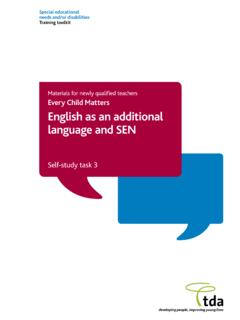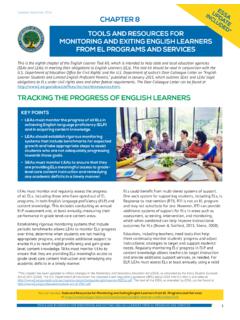Transcription of Supporting children learning English as an additional language
1 Supporting children learning English as an additional language guidance for practitioners in the Early Years Foundation Stage Supporting children learning English as an additional language Contents Introduction 2. The importance of home languages 4. About learning English as an additional language 4. Bilingual support 6. Theme: A Unique Child 7. Theme: Positive Relationships 10. Theme: Enabling Environments 12. Theme: learning and Development 14. References and further reading 19. Note Both parents and carers of children are included in the term parent' where used in this booklet. 00683-2007 BKT-EN Supporting children learning English as an additional language Crown copyright 2007 Primary National Strategy . Introduction There are increasing numbers of children entering Early Years Foundation Stage (EYFS) settings for whom English is not the dominant language in the home.
2 Many practitioners in settings across the country already work successfully with children and families who speak languages other than English . For some there will be one or two language groups represented in their setting;. for others the population may be linguistically and culturally very diverse. For growing numbers of settings, providing care and learning opportunities for children and families new to English , or at various stages of proficiency, is a new experience. Practitioners in every setting want to ensure that their provision matches the development and learning needs of all their children . This advice and guidance booklet is drawn from existing good practice developed by practitioners working with babies, young children and their families. This guidance is set within the themes, principles and commitments of the EYFS and should be read in conjunction with the Principles into Practice cards.
3 Following the introductory key messages the booklet is set out under the four themes offering extended Effective practice', Challenges and dilemmas' and Reflective practice' sections for: A Unique Child Positive Relationships Enabling Environments For the theme of: learning and Development the Effective practice' section is further broken down into sub headings. The principles of good practice for children learning English are the principles of good practice for all children . Effective practitioners include all children by meeting their needs. However, the skills, knowledge and understanding of children learning English as an additional language (EAL) are often underestimated. This makes it more likely that they will be vulnerable to poor Foundation Stage Profile outcomes and some may find it more difficult to achieve the Every Child Matters outcomes than their monolingual peers.
4 Although many children from EAL backgrounds who have poor outcomes at the end of the Foundation Stage go on to become among the highest achieving children , there are also many who do not catch up. The children learning EAL who are most vulnerable to poor outcomes at the end of the Foundation Stage and beyond are usually those with the least experience of being in an Early Years or Foundation Stage setting. Some of these children will be newly arrived to England, but many more will have remained at home because for whatever reason, either through choice or lack of appropriate and accessible information parents have not taken up the offer of free education for three- and four-year-old children before statutory school age. Supporting children learning English as an additional language 00683-2007 BKT-EN.
5 Primary National Strategy Crown copyright 2007. The EYFS framework requires all settings to ensure that there is equitable and inclusive provision for all our children . To enable practitioners to meet this requirement local authorities (LAs) will need to carefully and thoroughly plan, deliver and monitor the impact of all training and support. Before children and families can benefit from the high quality provision being developed within each LA they have to be accessing that provision. It is for LAs to ensure not only sufficiency of places, but accessible information that reaches those most in need of support. For those families who have previously found access difficult, and have therefore been in some way excluded, it is vital that potential barriers are recognised at every level so that they can be overcome.
6 The Early Years Outcomes duty, placed on all LAs as part of the children Act, requires them to address the gaps in achievement between different groups of children at the end of the Foundation Stage, measured by the Foundation Stage Profile outcomes. For many LAs, children for whom English is an additional language form an increasing percentage of the lowest achievers at the end of the Foundation Stage and these LAs will need to take specific action to support them in order to close the gap. All LAs should have a policy for community cohesion and engagement, part of which will address the needs of young children and their families for whom English is an additional language . The Inclusion Report, Sure Start for Everyone, suggests strategies that LAs could adopt to improve the engagement of families who might feel excluded from early education opportunities.
7 This report, in common with the practice guidance for Gypsy Roma Traveller families, and the children 's Centre toolkit, stresses the importance of cultural relevance for all families to ensure that they feel that settings are places where they can feel comfortable, respected, valued and included. It is recommended that this guidance is read within the context of these other materials Supporting practitioners to meet the needs of the communities they serve. The guidance will give a breadth of advice and support for practitioners working with children from birth to the age of five. It is to be remembered that children within this broad developmental span can be anywhere along the continuum of language development in one or more languages, from babies who are experimenting with sounds, to sophisticated and articulate children who can converse in one or more languages.
8 Some will be beginners in one language but proficient in another; others will be at varying stages of fluency in one, or more than one, language . Key messages in the document echo and complement the National Strategies guidance for Supporting the learning and teaching of bilingual children in the primary years. The term EAL recognises the fact that many children learning English in settings in this country are already developing one or more other languages and are adding English to that repertoire. 00683-2007 BKT-EN Supporting children learning English as an additional language Crown copyright 2007 Primary National Strategy . The importance of home languages Key principle Bilingualism is an asset, and the first language has a continuing and significant role in identity, learning and the acquisition of additional languages.
9 It is widely accepted that bilingualism confers intellectual advantages and the role of the first language in the child's learning is of great importance. children need to develop strong foundations in the language that is dominant in the home environment, where most children spend most of their time. Home language skills are transferable to new languages and strengthen children 's understanding of language use. Developing and maintaining a home language as the foundation for knowledge about language will support the development of English and should be encouraged. Insistence on an English -only approach to language learning in the home is likely to result in a fragmented development where the child is denied the opportunity to develop proficiency in either language . The best outcome is for children and their families to have the opportunity to become truly bilingual with all the advantages this can bring.
10 Home languages are also vital for maintaining positive family connections. It is therefore very important to maintain the language of the home, particularly where older family members who care for children do not speak English . Otherwise this may mean that eventually they are no longer able to have proper meaningful conversations with each other. Parents who cannot share thoughts and ideas with their children will inevitably lose the ability to shape, guide and influence their lives. Situations where this has happened have been documented, and shown to have negative social outcomes for communities because children have lacked the guiding hand of their elders. Practitioners have a key role in reassuring parents that maintaining and developing their home language will benefit their children and support their developing skills in English .






